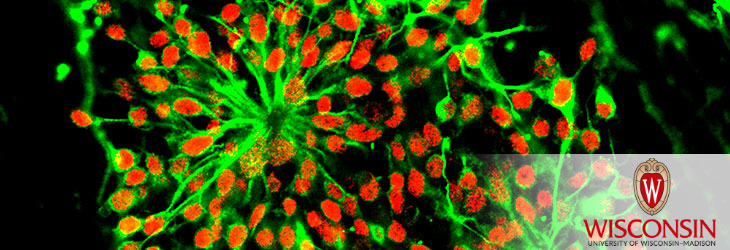Pluripotent Stem Cells

Human Pluripotent Stem Cell-Based Models for Neural Toxicity Screening
WARF: P140400US02
Inventors: James Thomson, William Murphy, Charles David Page, Michael Schwartz, Zhonggang Hou
The Wisconsin Alumni Research Foundation (WARF) is seeking commercial partners interested in developing a new platform for neural toxicity testing that combines tissue engineering and bioinformatics, and exceeds 90 percent accuracy.
Overview
There remains a need for models that recapitulate complex human tissues and biological processes, and are suitable for screening potentially hazardous compounds. Animal models are of limited value for predicting developmental neurotoxicity due to poorly understood differences with the human brain.
Human pluripotent stem cells (hPSCs) are a potential alternative. Previous in vitro studies have shown the capacity of hPSC-derived progenitor cells to self-assemble in layered neuronal tissues that resemble the neocortex. However, the models to date have lacked critical components of the developing brain such as blood vessels and microglia.
Human pluripotent stem cells (hPSCs) are a potential alternative. Previous in vitro studies have shown the capacity of hPSC-derived progenitor cells to self-assemble in layered neuronal tissues that resemble the neocortex. However, the models to date have lacked critical components of the developing brain such as blood vessels and microglia.
The Invention
UW–Madison researchers have developed 3-D vascularized neuronal tissue models for screening neurotoxic agents. The new constructs are highly uniform and the first to contain every major component of the developing brain: neuronal cells (GABAergic and Glutamatergic), glial cells (astrocytes and oligodendrocytes), interconnected vasculature and mature microglia.
Combined with the modular nature of tunable hydrogels and the power of machine learning tools, the new testing platform enables large-scale, quantitative throughput applications.
Combined with the modular nature of tunable hydrogels and the power of machine learning tools, the new testing platform enables large-scale, quantitative throughput applications.
Applications
- Predictive developmental toxicology screens
Key Benefits
- First model of its kind to recapitulate the complexity and organization of human tissue
- Comprises physiologically relevant human cells
- Highly sensitive
- System is efficient, reproducible and free of xenogenic material.
Stage of Development
Using global gene expression profiles from the tissues, the researchers developed a machine learning protocol that correctly classified greater than 90 percent of test compounds. Seventy compounds have been tested.
Additional Information
For More Information About the Inventors
Related Technologies
Tech Fields
For current licensing status, please contact Andy DeTienne at [javascript protected email address] or 608-960-9857